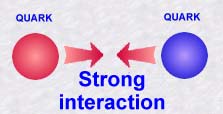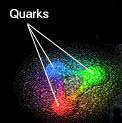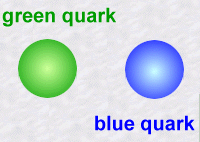The strong interaction
or
Super-gluon glue
or
Super-gluon glue
Strong interaction is responsible for the confinement of protons and neutrons inside atomic nuclei. Its intensity is considerable and it would dominate all of the other forces of nature if its range of action was not so miniscule (of the order of size of atomic nuclei, at 10-15 metres). This explains why in the nucleus, two protons, of the same positive charge Q, are not violently separated by the electromagnetic force: the strong interaction is much more powerfull.

In fact, the strong interaction exerts itself more fundamentally between
the constituants of the nucleons: the quarks (and the antiquarks). In the
same manner that the electromagnetic interaction only acts on particles
possessing a non zero charge Q, the strong interaction acts only on particles
bearing a characteristic named "colour". The theory explaining this
mechanism is called quantum chromodynamics (because chromo = colour)
or QCD.
![]()
![]() Quantum
chromodynamics
Quantum
chromodynamics
Quarks and antiquarks are thus characterised by a colour:
 Don't
imagine that these particles are coloured like billiard balls! this poetic
term has been imagined to name a new charge which doesn't concern anything
but the strong interaction.
Don't
imagine that these particles are coloured like billiard balls! this poetic
term has been imagined to name a new charge which doesn't concern anything
but the strong interaction.
With the quarks of a nucleon, everything goes in threes: The Q charges
are fractional thirds and importantly nucleons don't carry a particular
colour: they're white. This white cannot be obtained unless the three quarks
in a nucleon are all of a different colour. As in optics:
| RED + GREEN + BLUE = CYAN + MAGENTA + YELLOW = WHITE |
Notice that the family of leptons (electron, muon, tau and their neutrino)
is not sensitive to the strong interaction and therefore these particles
are not coloured.
As for quarks, the composite particles that they form by bunching together
are called hadrons. All of these hadrons are threefore sensitive
to the strong interaction and they all have a colour charge of zero: they
are therefore white.
There can be two different types:
| red quark + green quark + blue quark = neutral baryon |
Antibaryons contain 3 antiquarks of 3 anticolours and obey the rule
:
| cyan antiquark + magenta antiquark + yellow antiquark = neutral antibaryon |
| red quark + cyan antiquark = | neutral meson |
| green quark + magenta antiquark = | neutral meson |
| blue quark + yellow antiquark = | neutral meson |
![]()
![]() Gluons
Gluons
The strong interaction exherts itself via the intermediary of a boson or mediator particle. This boson has been named a gluon and there exist eight different ones; each carrier of a colour and an anticolour.
Like photons, there have zero mass and like the graviton, they still haven't ever yet been detected.
A gluon is thus always associated with a colour and with an anticolour; whenever it is exchanged between two quarks, it will change their colours. In contrast to the mediator photon which does not change the Q charges of the interacting particles, gluons, change the colour of the quarks.

It is therefore necessary to represent a nucleon as an incessant transformation of 3 quarks permanently exchanging gluons. At any given moment, the 3 quarks have 3 different colours, but these colours will constantly and alternately switch properties.


More surprising still, seen from very close, the quarks of a nucleon
seem free. On the other hand, if they move away from each other, the force
which ties them augments and they cannot get out of the nucleon. Quarks
and gluons are confined to the interior of baryons and mesons. Thus
two quarks of different colours are all the more attracted one to another
when they are distanced one from the other! It's as if they were linked
by elastic. This is the confinement of quarks.
We can never therefore observe a quark in isolation.
![]()
![]() The
inter-nucleon liaison
The
inter-nucleon liaison
The fundamental strong interaction exercises itself between the
quarks and the gluons of a nucleon.
The things which bind together the nucleons inside the atomic nucleus,
are the "flights" of gluons, quarks and antiquarks.
In
1937, the japanese physicist Hideki Yukawa proposed that the liaisons
between protons or neutrons are made by the intermediary of particles called
mesons p (Pi). These mesons Pi would
effectively be detected ten years later. In fact, we now know that mesons
are a necessary unstable association of quarks, antiquarks and gluons:
These meons are in some ways flights escaping from the nucleon and interacting
with the neighbouring nucleon: this is the residual strong interaction
acting secondarily between nucleons by virtue of the intermediary of mesons.